Hydrogen energy: A green revolution hiding in plain sight?
Imagine, just for a moment, that all the energy we could ever need (and more besides) was available at our fingertips, stored freely within the most common element on Earth. Imagine that this same energy could be harvested and used to power many sectors of our economy and multiple facets of human activity. And imagine that it could forever liberate us from the fossil fuels that do so much to harm our climate.
To the uninitiated it might sound like a science fiction daydream, some over-hyped panacea to our environmental woes. Yet, such a utopian scenario isn’t all that far removed from reality.
Say hello to hydrogen energy.
The proof of concept is well established, with hydrogen energy already being produced and used commercially around the world.
Hydrogen energy derives, as its name suggests, from the simplest and most abundant element in the universe – hydrogen. When a hydrogen gas flame burns in the air, energy is released from the reaction of oxygen (O2) with hydrogen (H2) – and this energy can be used as a fuel. And the by product? Water: H2O.
As so often, however, there is a slight hitch. At present, some 95% of hydrogen consumed globally utilizes fossil fuels somewhere in the production process.[1] The most popular method, Steam Methane Reforming (SMR), requires high-pressure high-temperature steam – the sort of energy source that only fossil fuels can currently supply and a serious drawback for hydrogen’s green credentials.
Yet the innovators of a future ‘hydrogen economy’ are not so easily deterred. Experts envisage a not-too-distant scenario where hydrogen both affordably and cleanly powers our day-to-day lives, even those aspects presently unsuited to electrification. Hydrogen could be used for long-term energy storage. For hydrogen-powered vehicles, as discussed in our Perspectives article. For heating. Even for mixing with captured CO2 and producing clean aviation fuel. All with no greater carbon footprint than a plume of water vapor spiraling harmlessly into the atmosphere.[2]
All that is needed for this energy revolution is some ingenuity, a little determination, and a fusion of the boldest brains in technology.
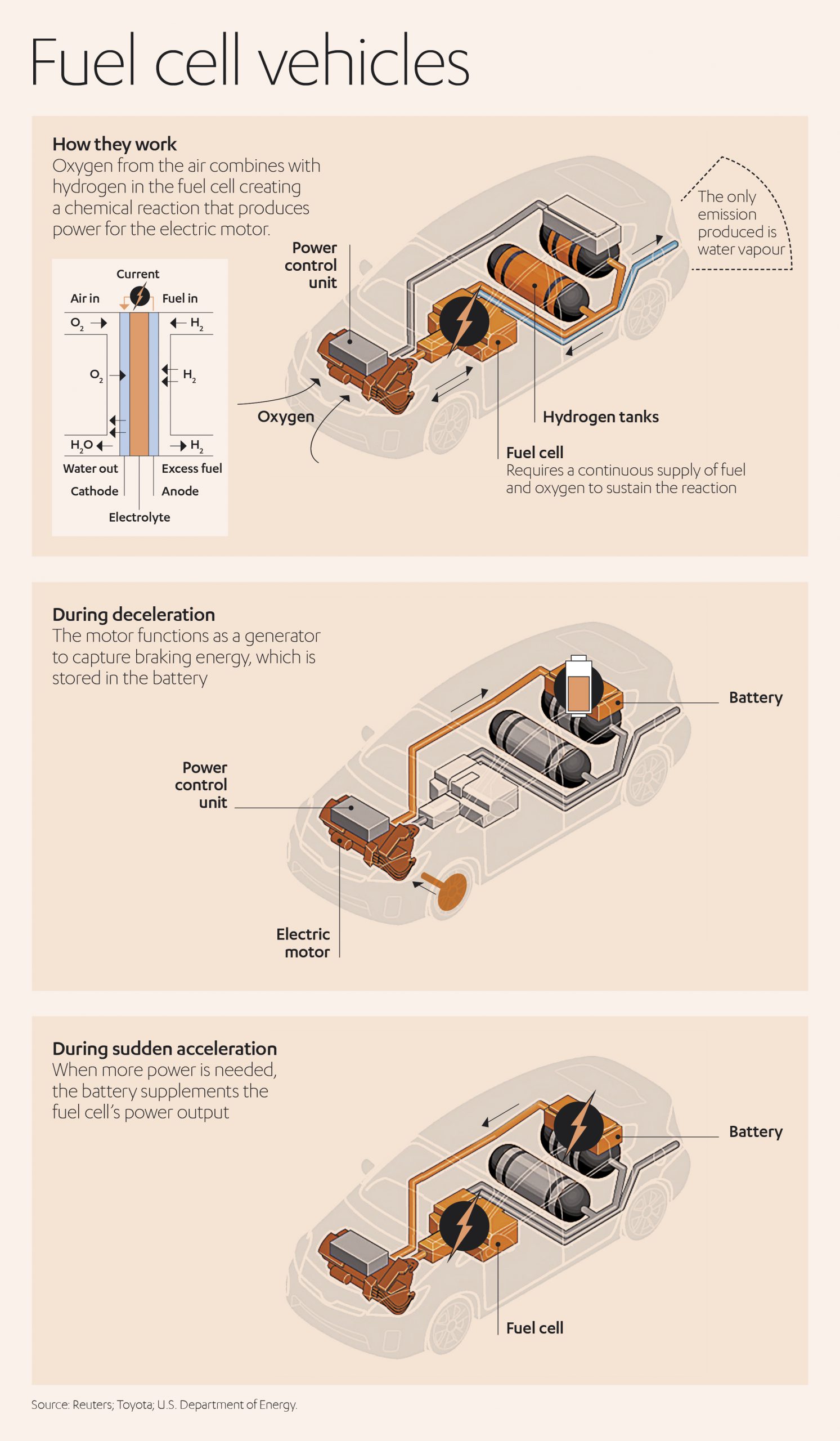
Unlocking a decarbonized future
So-called ‘green’ hydrogen uses, not fossil fuels, but renewable energy to power the electrolysis of water and produce hydrogen gas.
Transforming renewable energy into storable gas overcomes two of the limitations currently hampering renewables. Renewables are inconsistent (solar and wind power rely on the sun shining and the wind blowing, respectively) and their generation doesn’t always neatly sync with demand.
Apart from plentiful electricity, all one needs to produce green hydrogen is water and a piece of equipment known as an electrolyzer. Once you have that all-important end product, its versatility is unmatched.
Green hydrogen can be used for directly powering fuel cells in cars or ships, or burning in thermal power or heating plants, or simply helping replace some of the 10 million tons of industrial hydrogen produced from natural gas in the US annually.[3]
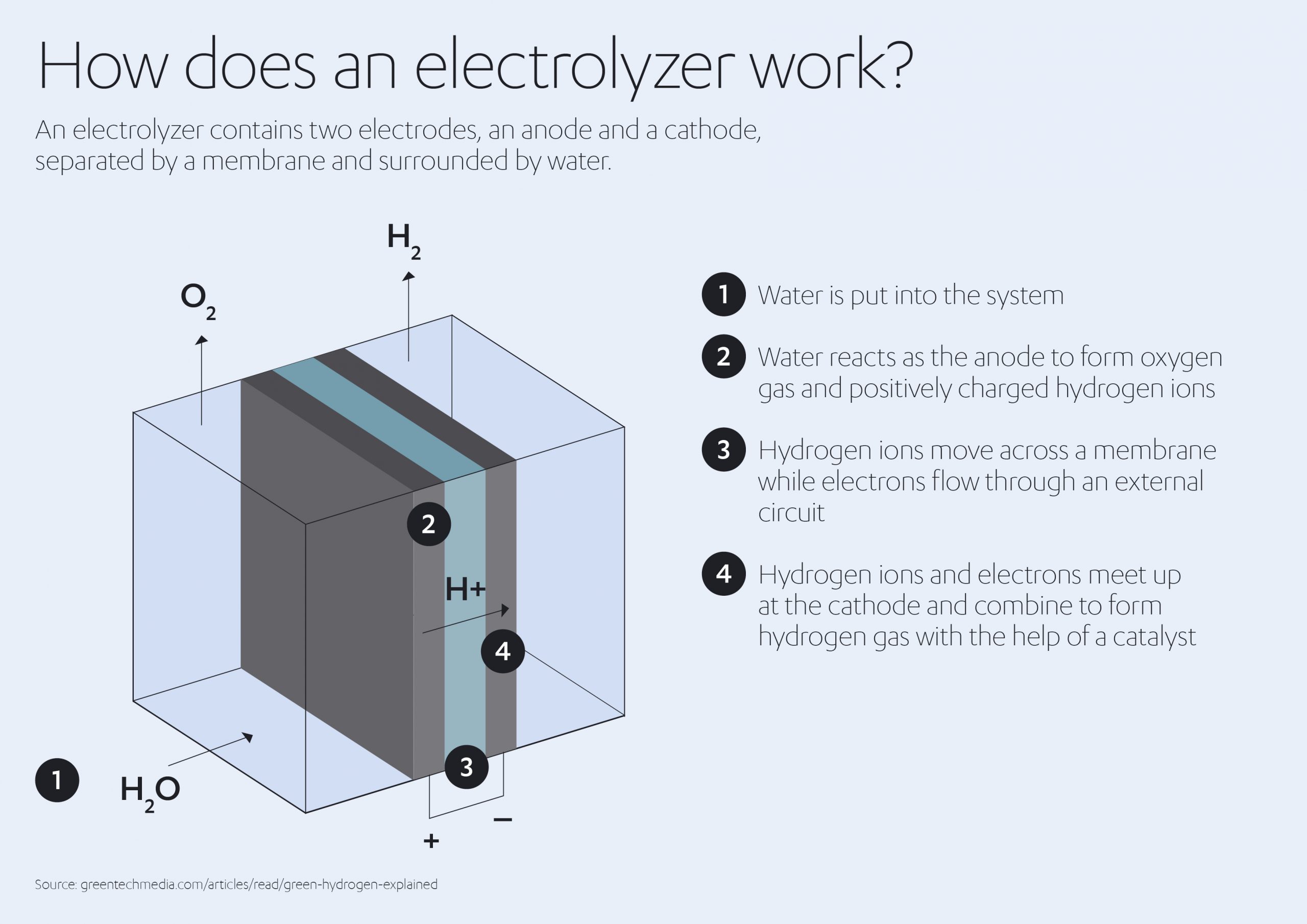
Little wonder some are hailing it as the next big thing, with both public and private sectors investing serious time and money in refining the process.
The development of clean hydrogen would overcome some of the challenges that have so far restrained hydrogen’s progress. Traditionally, producing hydrogen is not a clean process. Natural gas is the current primary source of hydrogen production and this fuel cost accounts for 45%-75% of total hydrogen production costs[4]. Producing hydrogen from fossil fuels also means that as demand for hydrogen has soared – it has trebled since 1975 – so too have the emissions generated by traditional hydrogen production. It now accounts for 830 million tons of CO2 per year, roughly the same as the total CO2 emissions of the UK and Indonesia combined[5].
Not just hot air
Fossil fuel companies are facing ever-more stringent constraints on their activities to help achieve the emissions reduction targets defined in the Paris Agreement. The Paris Agreement aims to limit the rise in average global temperature to well below 2°C this century compared to pre-industrial levels. Achieving this will require substantial emissions reductions across all sectors. As such, these organizations are frequently front and center in green hydrogen research.
Energy-related carbon dioxide emissions with current policies (Reference Case) compared to accelerated uptake of renewables (REmap), 2010–2050
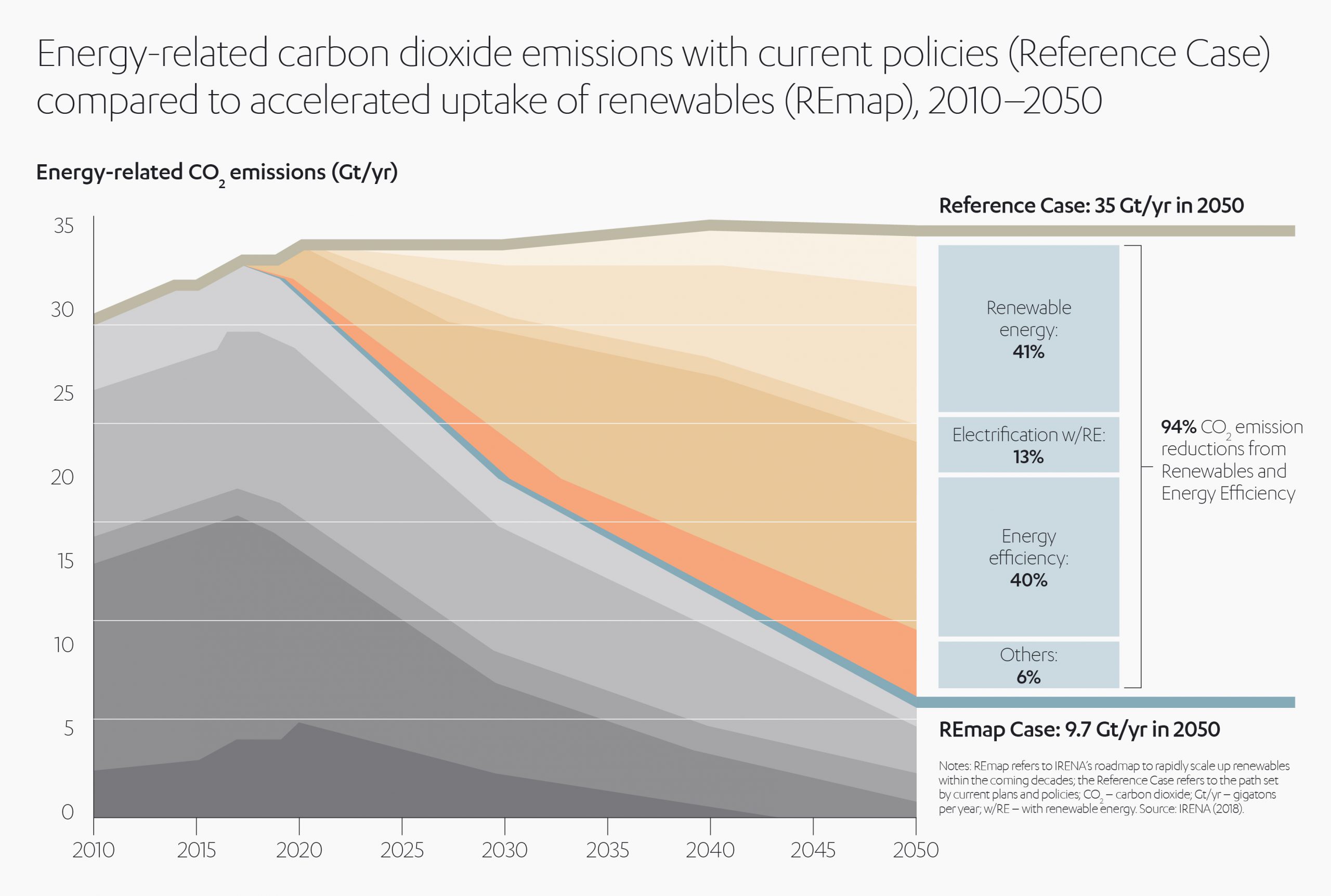
BP’s solar offshoot Lightsource BP, for instance, is moving forward on a 1.5 GW wind and solar powered green hydrogen plant in Western Australia.[6]
Shell Nederland, meanwhile, is partnering with Eneco on a bid for a share of a Dutch offshore wind tender to power a 200 MW hydrogen hub in the port of Rotterdam.[7]
Governments worldwide are climbing on the green hydrogen bandwagon. The UK, Germany, Japan and Australia – the latter boasting a US$ 200+ million kitty to kickstart efforts – have all unveiled hydrogen strategies. The Netherlands intends to have 500 MW of green electrolyzers operational by 2025, and Portugal is planning a new solar-powered plant to produce green hydrogen by 2023.[8]
It’s Europe where a lot of buzz is focused, with the European Commission identifying green hydrogen as a passport to achieving its aim of becoming carbon neutral by 2050. The EC’s phased strategy includes:
- installing at least 6 gigawatts of renewable hydrogen electrolyzers in the EU by 2024, capable of producing up to one million tons of renewable hydrogen
- installing at least 40 gigawatts of electrolyzers, producing up to ten million tons of renewable hydrogen, between 2025 and 2030
- deploying hydrogen technologies at large scale across all ‘hard-to-decarbonize’ sectors between 2030 and 2050[9]
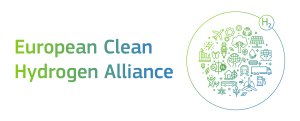 These do not appear to be mere empty promises. In fact, to ensure these ambitious goals are achieved, the EC has launched a new partnership called the European Clean Hydrogen Alliance.
These do not appear to be mere empty promises. In fact, to ensure these ambitious goals are achieved, the EC has launched a new partnership called the European Clean Hydrogen Alliance.
The alliance brings together national and regional leaders, banks and industry heads to secure an investment pipeline for scaling-up green hydrogen production, while also introducing common standards, terminologies and certifications.
With the alliance, the EU wants to build its global leadership in this domain, to support the EU’s commitment to reach carbon neutrality by 2050. All of which should promote investor certainty, thus ensuring the necessary infrastructure and logistical networks for green hydrogen to fulfill its potential.

European Commissioner for Energy
European Commissioner for Energy, Kadri Simson, said: “The EU’s energy system has to become better integrated, more flexible and able to accommodate the cleanest and most cost-effective solutions, and hydrogen will play a key role in this, as falling renewable energy prices and continuous innovation make it a viable solution for a climate-neutral economy.”[10]
Will price pop hydrogen’s balloon?
As in most walks of life, money talks, and hydrogen is not cheap. According to the European Bank for Reconstruction and Development (EBRD), green hydrogen currently costs around US$ 3-6 per kilogram compared to US$ 1-1.8 per kilogram for hydrogen made from fossil fuels.[11]
That’s admittedly a drawback. And there’s another.
The International Renewable Energy Agency (IRENA) imagines some 19 exajoules of hydrogen from renewable electricity in the global energy mix by 2050. Yet producing that amount of renewable hydrogen (or hydrogen-based products) will require anywhere from 4-16 terawatts of solar and wind power.[12]
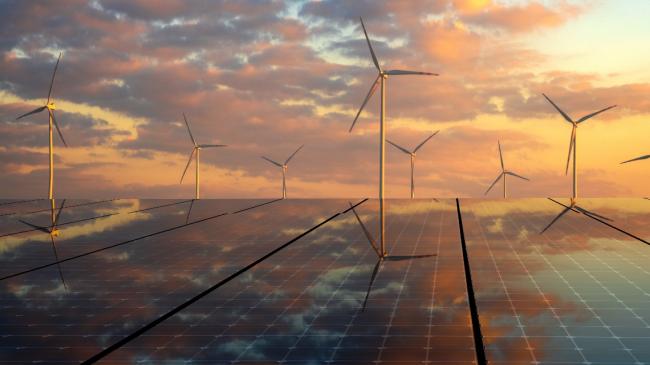
It has been calculated that producing 19 exajoules of hydrogen will entail at least 6,690 TWh of electricity annually – equivalent to 1,775GW of offshore wind farms, 2,243GW of onshore wind, 4,240GW of solar PV or 957GW of nuclear power.[13] Quite a step up from our current installed capacity: 23.4GW of offshore wind, 540.4GW of onshore wind, 480.4GW of solar PV and 397GW of nuclear power.
These daunting figures explain why some industry experts are advocating for an interim measure of so-called ‘blue hydrogen’ – hydrogen produced using natural gas and CCUS (carbon capture, utilization, and storage). Unfortunately, only around 80% of carbon emitted during this process can be ‘captured’, so an energy ecosystem reliant on blue hydrogen would still be responsible for millions of tons of emissions each year.[14]
While pure cost comparisons appear unfavorable for green hydrogen, it is worth remembering the age-old principle of supply and demand. Prices will inevitably decline as usage increases.
The European Bank for Reconstruction and Development (EBRD), for instance, expects falling electrolysis costs, coupled with cheaper renewable energy, to cut the price of green hydrogen to no more than US$ 1.50 per kilogram by 2050 making it comparable with natural gas – even more so, if carbon penalties further tighten the noose on fossil fuels.
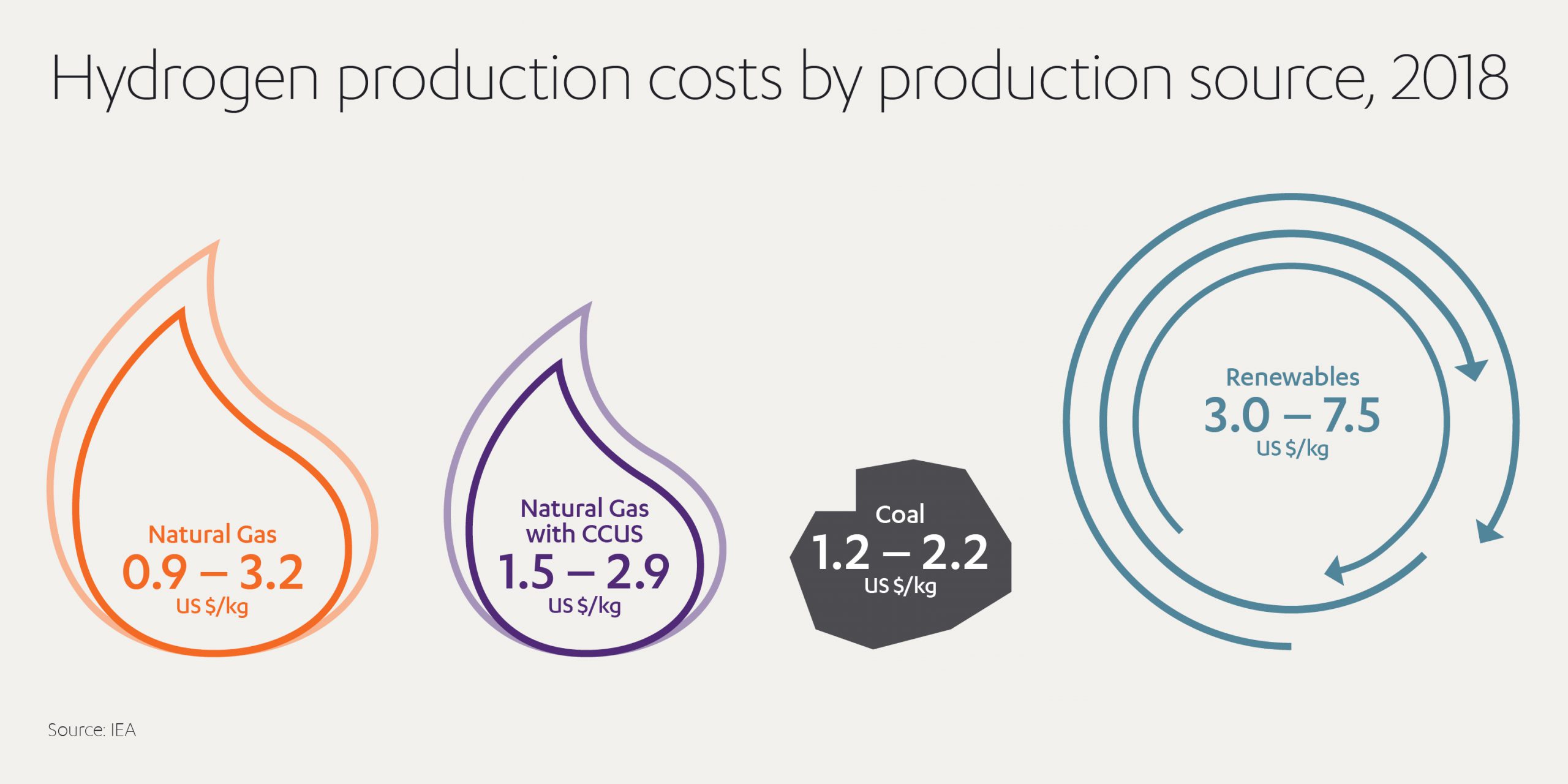
“We are probably in the same situation as we were a decade or two ago with renewable energy where the solution is more expensive than the alternatives. If things keep going and if there is a policy push going forward, our expectation is that it will become cost-competitive soon,” says Christian Carraretto of the EBRD.[15]
Similarly, in its “Future of Hydrogen” report[16], the IEA predicts the cost of producing hydrogen from renewable energy could fall by 30% by 2030 as a result of declining costs of renewables and the scaling up of hydrogen production.
Says the IEA: “With declining costs for renewable electricity, in particular from solar PV and wind, interest is growing in electrolytic hydrogen and there have been several demonstration projects in recent years… With declining costs for solar PV and wind generation, building electrolyzers at locations with excellent renewable resource conditions could become a low-cost supply option for hydrogen.”
The policy perspective
Hurdles notwithstanding, IRENA has no hesitation in identifying renewable-derived hydrogen as the ‘missing link’ in the energy transition, powering sectors otherwise difficult to decarbonize through electrification.
It recognizes, however, that a welcoming policy and regulatory framework is critical for attracting the necessary private investment.
As such, IRENA recommends:
- designing financial support instruments, such as capital expenditure subsidies and tax rebates, to offset the initial cost of new technologies
- introducing emissions restrictions and mandates for renewable energy content in industry to encourage greater hydrogen demand
- establishing long-term gas grid injection tariffs
- enabling electrolyzer operators to participate in ancillary service markets
- de-risking investments to spur market uptake and support infrastructure and hydrogen rollout[17]
Plus, IRENA notes, there is every reason to expect appetite for green hydrogen to increase as key technologies mature.
Proton-Exchange Membrane (PEM) electrolyzers and fuel cells are approaching economies of scale, with commercial deployment already under way in key markets such as Japan, California and Europe.[18]
Furthermore, new electrofuels can frequently replace fossil fuels seamlessly without the need to adapt equipment at point-of-use – potentially important for sectors such as aviation.
Several industries have already been identified where green hydrogen can make immediate and substantial inroads into climate goals. These include large-scale operations such as petrochemicals and steel manufacture, and medium to heavy-duty transport vehicles such as buses, trucks, trains and ships.
Mobility is perhaps one of the highest profile sectors already well on the way to leveraging the benefits of hydrogen, while also helping to change perceptions.
Japan is a world leader in hydrogen fuel-cell vehicles. It aims to have 200,000 hydrogen vehicles on the road by 2025, rising to 800,000 in 2030[19]. These will be supported by a national network of hydrogen refueling stations designed to put millions of hydrogen vehicles onto the nation’s roads. Looking further ahead, it is targeting 320 hydrogen stations operational by 2025 and 900 by 2030[20].
Japanese automotive giant and long-standing Abdul Latif Jameel partner Toyota Motor Corporation has long maintained that hydrogen fuel cell technology could power a broad spectrum of vehicle types, and sees global sales of fuel cell electric vehicles increasing significantly over the next decade. In line with these expectations, it plans to produce over 30,000 fuel cell electric cars annually by the end of 2021[21] – a significant rise from 3,000 per year in 2018.
Indeed, it was the Toyota Mirai hydrogen powered vehicle, supplied by Abdul Latif Jameel, that was chosen to launch Saudi Arabia’s first hydrogen fuel cell refueling station in the Dhahran Techno Valley Science Park in 2018[22]. A sure sign that hydrogen energy is on the move.
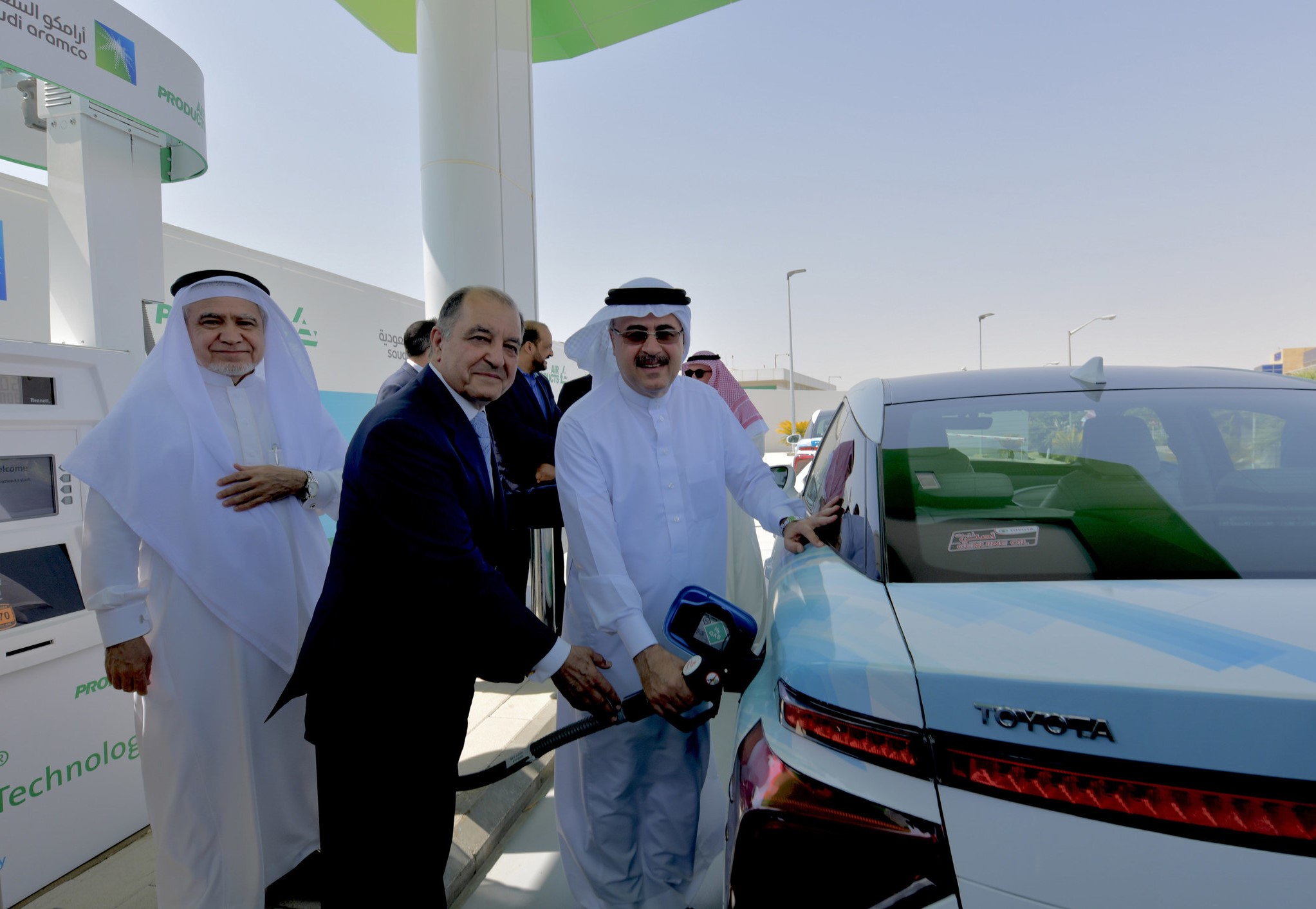
Hydrogen heralds a battery of breakthroughs
How do we store all this clean hydrogen energy we hope to one day produce, and how do we use it to electrify industry and transport? Batteries and fuel cells.
These overlapping technologies have the shared ability to convert stored electricity into chemical energy, ready for use whenever and wherever it is needed.
According to the International Energy Agency (IEA), the world’s capacity for making battery cells has expanded exponentially in recent years, producing 320 GWh of batteries for electric vehicles (EVs) annually as of 2020.[23] That’s more than enough to power the 2.1 million EVs sold in 2019, but falls short of the 1,000 GWh of capacity needed by 2025 if EV sales targets are met. China is the pacesetter in this department, meeting around 70% of global capacity, followed by the United States at 13%.
Europe, by contrast, is leading the way on electrolyzer production for hydrogen energy, with an annual manufacturing capacity of 1.2 GW, enough for 500,000 fuel cell cars. Momentum is growing, with ITM Power completing construction on the world’s largest electrolyzer plant (forecast to produce 1 GW a year) in Sheffield, UK, in early 2021.[24]
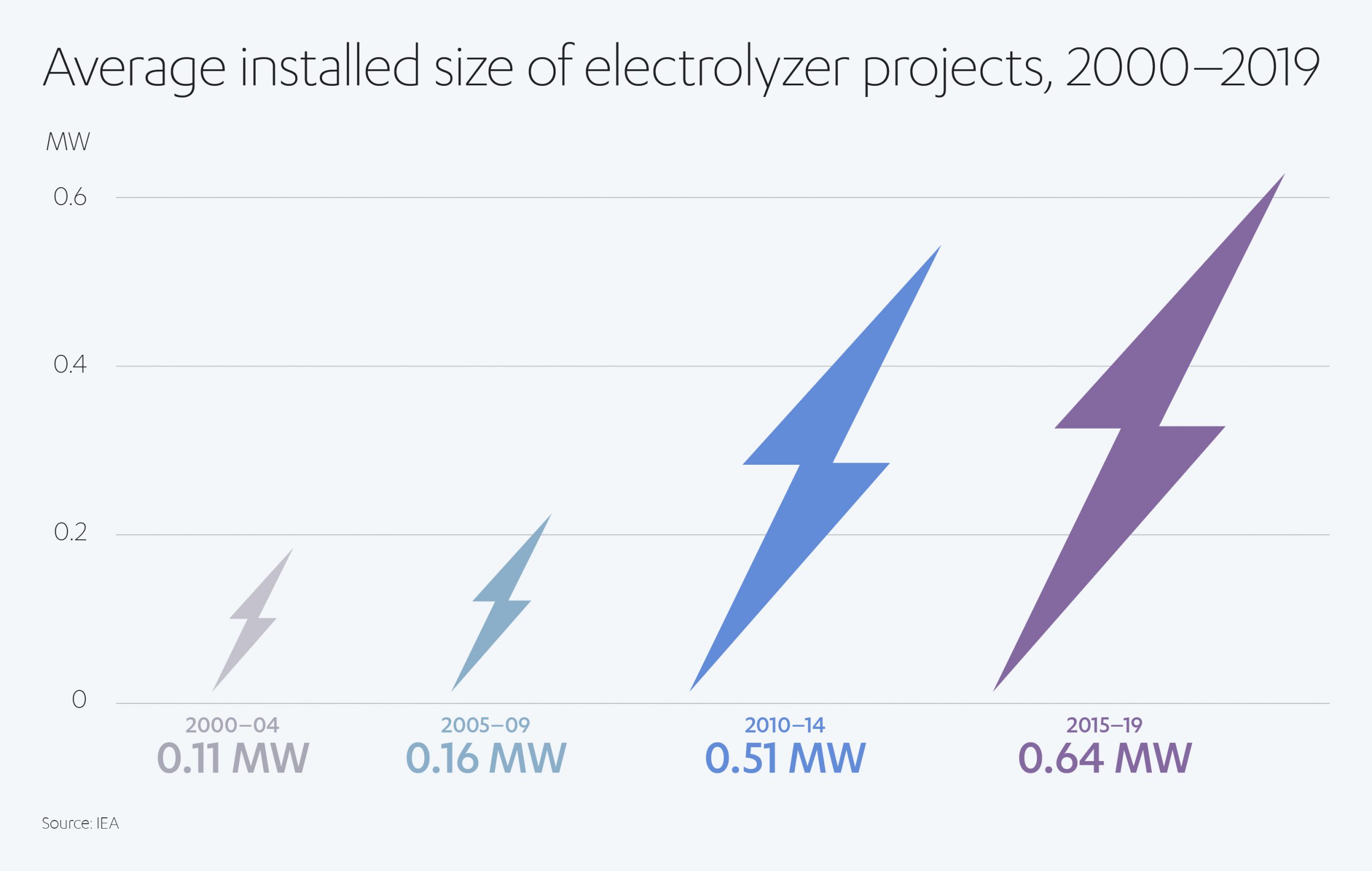
“Ideally, clean energy stimulus packages will include battery and electrolyzer manufacturing simultaneously in order to take advantage of the spill-over benefits between the two technologies,” says the IEA.[25]
At Abdul Latif Jameel, we are firm believers in the idea that private investors can encourage governments and big business to accelerate the green agenda. With our boundary-pushing technical portfolio, we are well placed to augment the field of hydrogen energy, thanks in part to our pioneering research in battery energy storage.
In November 2020, via renewable energy specialist Fotowatio Renewable Ventures (FRV), part of Abdul Latif Jameel Energy, we embarked on our second utility-scale battery project in West Sussex, UK. The 34 MW Contego project, developed in partnership with Harmony Energy, incorporates a system of 28 Tesla Megapack lithium-ion batteries.
The Contego project builds on the success of FRV’s earlier 7.5 MW battery plant at Holes Bay, Dorset, and is part of its continuing commitment to pushing forward the boundaries in renewable energy – including hydrogen.

A commitment that prompted Fady Jameel, Deputy President and Vice Chairman, Abdul Latif Jameel, to hail Abdul Latif Jameel’s determination “to shape a sustainable and renewable energy model as part of the UK’s ongoing transition from fossil fuels”.
And transition we must, if we intend to leave a planet that is both habitable and prosperous for our future generations. The role of hydrogen energy in this brave new energy world has still to come fully into focus.
But the potential of green hydrogen to power large swathes of our society cleanly and sustainably cannot be ignored.
Technological advances in the field of hydrogen energy are rampant.
If public policy evolves just as swiftly, we could truly witness that humble element leap from the periodic table to an altogether grander status on the global stage.
[1] https://www.vox.com/energy-and-environment/2018/2/16/16926950/hydrogen-fuel-technology-economy-hytech-storage
[2] https://webstore.iea.org/download/direct/2803?filename=the_future_of_hydrogen.pdf
[3] https://www.greentechmedia.com/articles/read/green-hydrogen-explained
[4] The Future of Hydrogen, IEA
[5] The Future of Hydrogen, IEA
[6] https://www.reuters.com/article/us-bp-hydrogen-australia-idUSKBN22K0IC
[7] https://www.smart-energy.com/renewable-energy/shell-eneco-announce-dutch-wind-powered-green-hydrogen-hub/
[8] https://www.ebrd.com/news/2020/is-green-hydrogen-the-sustainable-fuel-of-the-future-.html
[9] https://ec.europa.eu/commission/presscorner/detail/en/ip_20_1259
[10] https://ec.europa.eu/commission/presscorner/detail/en/ip_20_1259
[11] https://www.ebrd.com/news/2020/is-green-hydrogen-the-sustainable-fuel-of-the-future-.html
[12] https://www.irena.org/newsroom/articles/2019/Oct/Unprecedented-momentum-for-green-hydrogen
[13] https://www.rechargenews.com/transition/a-wake-up-call-on-green-hydrogen-the-amount-of-wind-and-solar-needed-is-immense/2-1-776481
[14] https://www.rechargenews.com/transition/a-wake-up-call-on-green-hydrogen-the-amount-of-wind-and-solar-needed-is-immense/2-1-776481
[15] https://www.ebrd.com/news/2020/is-green-hydrogen-the-sustainable-fuel-of-the-future-.html
[16] The Future of Hydrogen, IEA
[17] https://www.irena.org/-/media/Files/IRENA/Agency/Publication/2018/Sep/IRENA_Hydrogen_from_renewable_power_2018.pdf
[18] https://www.irena.org/-/media/Files/IRENA/Agency/Publication/2018/Sep/IRENA_Hydrogen_from_renewable_power_2018.pdf
[19] Japan: Taking a Lead in Hydrogen,
[20] Japan Sees Big Future in Hydrogen Cars
[21] Toyota plans to expand production, shrink cost of hydrogen fuel cell vehicles
[22] Saudi Aramco and Air Products to build Saudi Arabia’s first hydrogen fuel cell vehicle fueling station
[23] https://www.iea.org/articles/batteries-and-hydrogen-technology-keys-for-a-clean-energy-future
[24] https://renewablesnow.com/news/itm-power-moves-in-1-gw-per-year-electrolyser-plant-in-sheffield-726704/
[25] https://www.iea.org/articles/batteries-and-hydrogen-technology-keys-for-a-clean-energy-future





 1x
1x

 Added to press kit
Added to press kit


